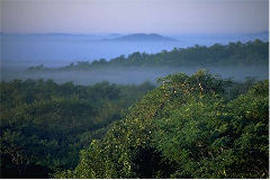El Nino in 1997
 The El Niño effect occurs every two to seven years, and is caused when the strong westward blowing trade winds drop, and warm water moves back eastward across the Pacific Ocean. The Peruvians named the phenomenon ‘El Niño’ – the Christ child, because it tends to begin around Christmas.
The El Niño effect occurs every two to seven years, and is caused when the strong westward blowing trade winds drop, and warm water moves back eastward across the Pacific Ocean. The Peruvians named the phenomenon ‘El Niño’ – the Christ child, because it tends to begin around Christmas.
Damage caused by El Niño can often be quite extensive. It can cause drought and bush fires, floods and landslides. While the El Nino weather system originates in the Tropical Pacific, it's impact on weather and climate is global.
In 1997 human error coupled with a particularly strong El Niño led to an environmental disaster in Indonesia and other southeast Asian counties. Logging companies in Indonesia had been clearing areas of forest by deliberately setting fire to them. Normally, regular rainfall would dampen down the flames and prevent the spread of fires. El Niño had stopped the rains from reaching Indonesia, so the fires burned completely out of control. The huge clouds of smoke caused unprecedented levels of smog, and made the air in certain areas of southeast Asia extremely dangerous to breathe.
At the height of the smog, levels of airborne pollution went off the scale in many Indonesian cities. The 24 hour Pollution Standards Index (PSI) works on a scale of 0 - 400, with a level above 400 being life-threatening to ill and elderly people. PSI Levels of over 500 were recorded, estimated to be equivalent to smoking two packets of cigarettes per day.
People were advised not to go outdoors in the smog unless wearing appropriate protective masks. In Malaysia, it was a legal requirement for people working outdoors in PSI levels of 300 or above to be supplied with respirators by their employers. When the PSI level rose to more than 400, it was illegal for anyone but emergency workers to be working outdoors.
The inhabitants of some cities did not see the sun for days, as the clouds of smoke were too dense. Ships collided on two occasions in the Strait of Malacca.
Read More: El Nino in 2014 - 2016